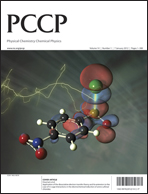The stability of CsGeX3 (X=I, Br, Cl) selectively tuned by the crystal structures and halide ion inferred from the calculated phonon spectrum
IF 2.9
3区 化学
Q3 CHEMISTRY, PHYSICAL
引用次数: 0
Abstract
In spite of the considerable advancements achieved in enhancing the power conversion efficiency (PCE) of lead-based all-inorganic perovskite solar cells, there persists a need for materials that are both more stable and environmentally friendly. This investigation systematically explores the structural, thermodynamic stability, and electronic properties of Ge-based all-inorganic perovskite CsGeX3 (X=Cl, Br, I) in two space groups, Pm¯("3" )m and R3m, utilizing first-principles calculations. Introducing the novel concept of the "imaginary frequency coefficient" alongside the tolerance factor and stabilizing chemical potential window, we collectively characterize the stability of CsGeX3 based on phonon spectrum and phonon density of states calculations. The findings reveal that the stable phase of Ge-based perovskite differs from that of lead-based systems, with the R3m structure of CsGeX3 as the most stable in the rhombohedral phase. Moreover, the stability of R3m-CsGeX3 can be manipulated by adjusting the halide composition with a gradual increase in stability observed as halogen atoms shift from I to Cl. This comprehensive approach, integrating the phonon spectrum, innovative measurement indicators, and tolerance factor, presents an effective strategy for designing materials that are both non-toxic and stable通过计算声子谱推断出的晶体结构和卤化离子选择性调节的 CsGeX3(X=I、Br、Cl)的稳定性
尽管在提高铅基无机包晶太阳能电池的功率转换效率(PCE)方面取得了长足的进步,但人们仍然需要更稳定、更环保的材料。本研究利用第一性原理计算,系统地探讨了 Pm¯("3" )m 和 R3m 两个空间群中 Ge 基全无机包晶 CsGeX3(X=Cl、Br、I)的结构、热力学稳定性和电子特性。我们引入了 "虚频系数 "这一新颖的概念,并结合容限因子和稳定化学势窗口,根据声子谱和声子态密度计算,共同描述了 CsGeX3 的稳定性。研究结果表明,锗基包晶石的稳定相不同于铅基体系,CsGeX3 的 R3m 结构是斜方体相中最稳定的。此外,R3m-CsGeX3 的稳定性可以通过调整卤化物成分来控制,当卤原子从 I 转变为 Cl 时,稳定性会逐渐增强。这种将声子光谱、创新测量指标和容差因子融为一体的综合方法,为设计既无毒又稳定的材料提供了一种有效的策略。
本文章由计算机程序翻译,如有差异,请以英文原文为准。
求助全文
约1分钟内获得全文
求助全文
来源期刊

Physical Chemistry Chemical Physics
化学-物理:原子、分子和化学物理
CiteScore
5.50
自引率
9.10%
发文量
2675
审稿时长
2.0 months
期刊介绍:
Physical Chemistry Chemical Physics (PCCP) is an international journal co-owned by 19 physical chemistry and physics societies from around the world. This journal publishes original, cutting-edge research in physical chemistry, chemical physics and biophysical chemistry. To be suitable for publication in PCCP, articles must include significant innovation and/or insight into physical chemistry; this is the most important criterion that reviewers and Editors will judge against when evaluating submissions.
The journal has a broad scope and welcomes contributions spanning experiment, theory, computation and data science. Topical coverage includes spectroscopy, dynamics, kinetics, statistical mechanics, thermodynamics, electrochemistry, catalysis, surface science, quantum mechanics, quantum computing and machine learning. Interdisciplinary research areas such as polymers and soft matter, materials, nanoscience, energy, surfaces/interfaces, and biophysical chemistry are welcomed if they demonstrate significant innovation and/or insight into physical chemistry. Joined experimental/theoretical studies are particularly appreciated when complementary and based on up-to-date approaches.
 求助内容:
求助内容: 应助结果提醒方式:
应助结果提醒方式:


